“Somewhere beneath the dust may be the first skeleton of a Paleo Indian to be found in the Western Hemisphere.”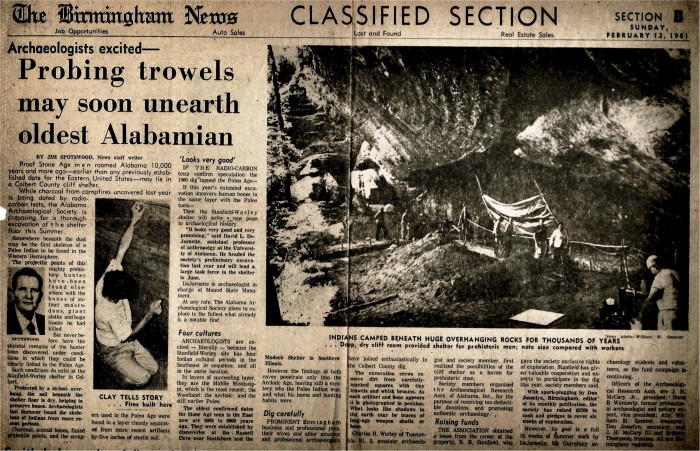
Confirmation established by discoveries at Russell Cave
Paleo-Indian culture of seminomadic hunter-foragers lived in open countryside and in natural rock shelters (e.g. Russell Cave in Jackson County and the Stanfield-Worley bluff shelter in Colbert County) 10,000 BC to 7000 BC.
Previously confirmed dates for Stone Age men in the East was 8000 to 9000 years ago. The confirmation was established by discoveries at Russell Cave near Scottsboro and the Modock Shelter in Southern Illinois.
Archaeologists throughout the world took notice in 1961
In Colbert County, there is a place called the Stanfield-Worley Bluff Shelter that excited archaeologists throughout the world around 1961 when charcoal from campfires found there was believed to provide proof that Stone Age men roamed Alabama 10,000 years and more ago. By 1960, it was clear that north Alabama had possibly the densest concentration of Paleo-Indian sites within the United States. During the years of 1961-1963, the state of Alabama was experiencing Civil Rights struggles which probably diverted attention away from this historic discovery and it did not receive the attention it probably would merit. 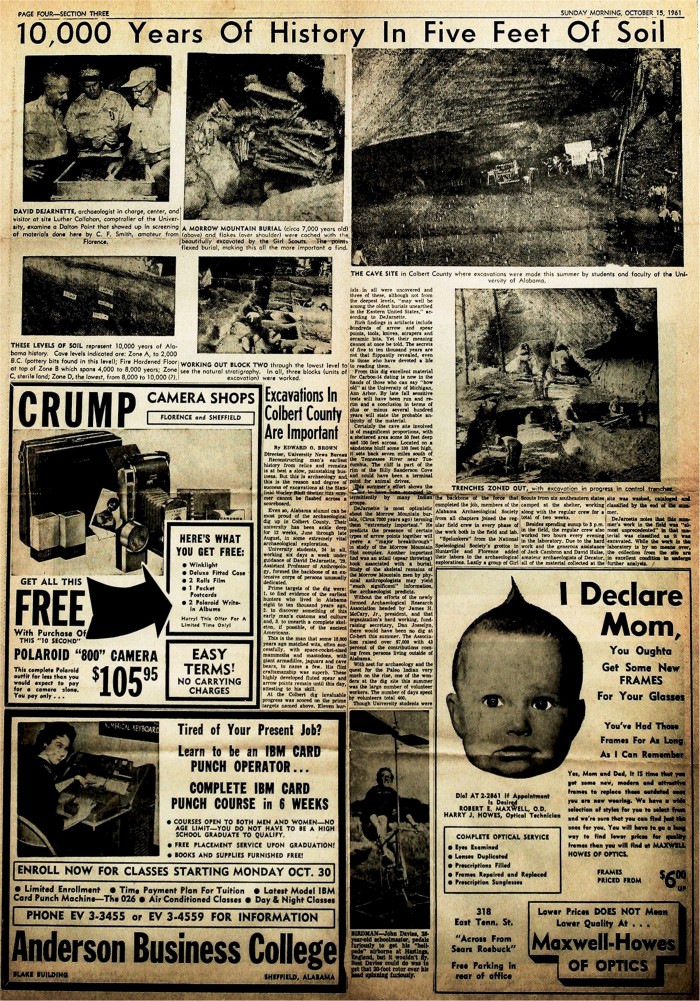
I can never forget her words – they left an indelible impression on me -Click to read a true story of how Hitler took over Germany.
One of most prehistoric sites excavated in the state
The Stanfield-Worley Bluff Shelter, located on private property of R. B. Stanfield in Colbert County in northwestern Alabama, United States, is one of the most important prehistoric sites excavated in the state due to the archeological evidence deposited by the Paleo-Indians who once occupied the rock shelter.
The site was unique because it has four Indian cultural periods in the Southeast in sequence, and all in the same location. Charles H. Worley, an amateur archaeologist, first recognized the cliff shelter as a haven for prehistoric man.
Stratigraphic zones exposed during excavation at Stanfield-Worley Bluff Shelter
Well-protected environment for the Native American occupants
Lying in Sanderson Cove along a tributary of Cane Creek approximately seven miles south of the Tennessee Valley, the shelter and the high bluffs of the surrounding valley provided a well-protected environment for the Native American occupants.
Paleo-Indian culture of seminomadic hunter-foragers lived in open countryside and in natural rock shelters (e.g. Russell Cave in Jackson County and the Stanfield-Worley bluff shelter in Colbert County) 10,000 BC to 7000 BC.
The excavation of the Stanfield-Worley Bluff Shelter commenced in 1960, after gaining approval of the property owner, Robert B. Stanfield.
Overview of Stanfield-Worley Bluff Shelter illustrating trench and block excavation
Partnership between the University of Alabama and Archaeological Research Association
The project was under the guidance of the North Alabama Project, a partnership between the University of Alabama and the Archaeological Research Association of Alabama. The first two field seasons (1960 and 1961) were reported by David L. DeJarnette and colleagues.A report, entitled “Stanfield-Worley Bluff Shelter Excavations,” was in the Journal of Alabama Archaeology, 1962, from the DeJarnette Research Center at Moundville, Alabama. The authors were David L. DeJarnette, Edward B. Kurjack and James W. Cambron. The excavation of the third and final season (1963) was smaller in scale with the results never being published.
Big Sandy projectile points collected at Stanfield-Worley Bluff Shelter
Excavations remained unreported
For all Stanfield-Worley’s importance, the 1963 excavations along with recovered cultural material and data have been little studied and remain unreported. By 1963, Edward B. Kurjack had left the University of Alabama to carry out a settlement pattern survey at Dzibilchaltun—the subject of his doctoral dissertation at Ohio State. Oscar Brock was assigned to duties at Mound State Monument. The two men visited the site again in 2008 and their experience is written up in Stones & Bones, The Newsletter of the Alabama Archaeological Society, Volume 50, Issue 4, July-October 2008
During the year of 1963, the state of Alabama was experiencing Civil Rights struggles which probably diverted attention away from this historic discovery and it did not receive the attention it probably would have normally received.
The Stanfield-Worley shelter remains on private property and According to The Earliest Americans Theme Study for the Eastern United States, Stanfield-Worley Rock Shelter is considered a strong candidate for National Historic Landmark status
Source
Stanfield-Worley Bluff Shelter Excavations (Journal of Alabama Archaeology Volume VIII No 1 and 2, June, December 1962) at Amazon.com
at Amazon.com
Books by Donna R. Causey
ALABAMA FOOTPRINTS Exploration: Lost & Forgotten Stories (Volume 1) is a collection of lost and forgotten stories about the people who discovered and initially settled in Alabama.
Some stories include:
- The true story of the first Mardi Gras in America and where it took place
- The Mississippi Bubble Burst – how it affected the settlers
- Did you know that many people devoted to the Crown settled in Alabama –
- Sophia McGillivray- what she did when she was nine months pregnant
- Alabama had its first Interstate in the early days of settlement


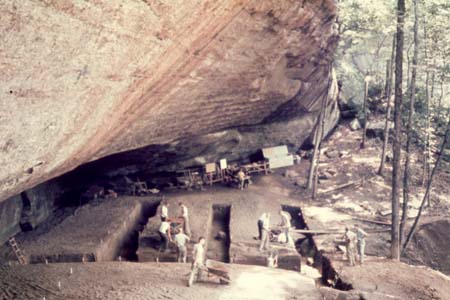
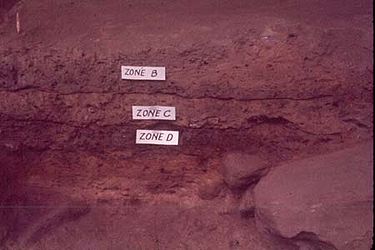
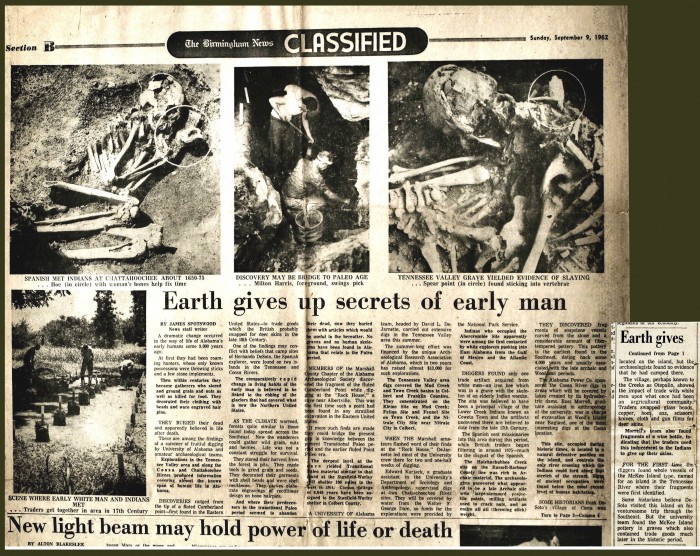
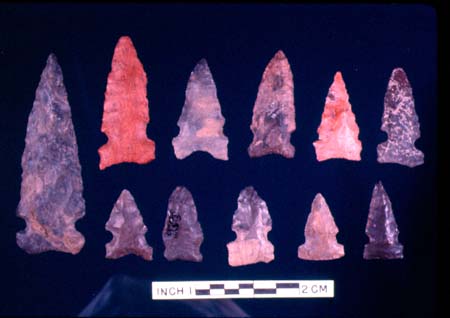
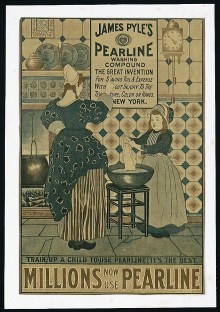

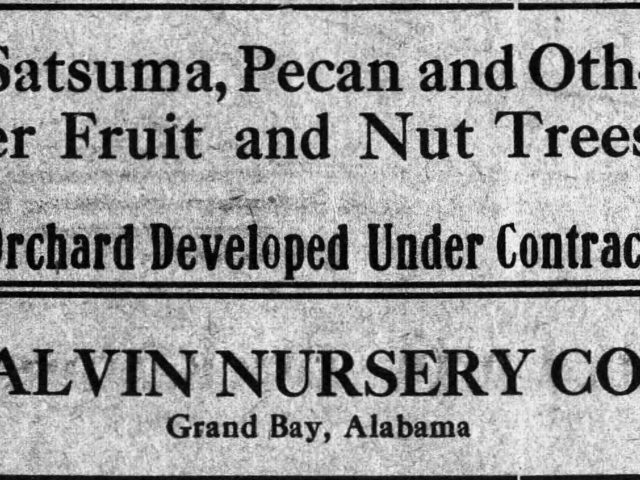
Lesley Ballard Bozeman
I was a member in a Deer hunting club in Monroe co Al 1985 to 1995 Those arrow heads in the photo are what I found in the rolling hills .100’s of them . Showed them to a game warden .He said 7000 years ago they were spear heads used to throw down hill on bison .
Becky Copeland Daniel Copeland Sarah Copeland Elisabeth Copeland Page
Is this were the Rattlesnake saloon is located ?
sure does look jut like the saloon
Lori N Samuel
Cynthia Riley thought of y’all while reading this.
Very interesting.
did they use sonar before digging?
Thank you Mike Willis! My husband and I are planning a motorcycle ride to see this!
I’ll bet there are some Indians buried there
May be some of our kinfolk
I hope they protect the site.
I remember the Worley Museum, and still have some of their folders, and books they sold. It was out on HWY 20 in Colbert County.
I remember the petrified dog and bins full of WWI & WWII photographs of piled up bodies. I’ve always wondered what happened to all the “stuff”. My dad always called Mr Worley, “ole man Worley”.
I remember my brother David remarking about that “Old dead dog.”
I wish they would make this a protected place.
Kathy…my sister and I are granddaughters of Charles Worley who found artifacts
at Stanfield-Worley Bluff which, we think, set the excavation in motion. We are
wanting to nominate the site for historical status with the Alabama Register of Landmarks
and Heritage. We have unsuccessfully been able to locate anyone in the
Stanfield family to let them know of our intentions. Can you help us?
This looks like a place they have developed to a tourist attraction. Bill look up the Rattlesnake Saloon. It is very similar.
It looks similar to the shelter in Dismal’s Canyon, a tourist attraction about 15 miles south of Colbert County.
I think it’s a honky tonk called Rattlesnake Saloon now.
I think it’s a honky tonk called Rattlesnake Saloon now.
It’s on the same bluff except further to the east from Rattlesnake Saloon. They aren’t too far apart, I’ve hiked and camped at both places, The Stanfield-Worley Shelter is a nice place to check out, it still has big holes in rocks where the Native Americans would grind corn and stuff. I was fortunate to know the owners of both sites, so I was able to explore that area when I was a youngster and hiking a mile or two to camp out, was no big deal, now if there isn’t an Airconditioned Camper/Motor Home at end of hike, I’ll pass. Lol
The Pelham Indians populated much North Alabama.Pelham range was covered with Graves and such
Many yeRs ago they stopped shelling llong enough for an archeologist to look around and retrive what he could.He was sad about what had already been destroyed by the shelling.And he had to leave a lot behind
Pamela Hamm. What are the Pelham Indians ? . PELHAM happens to be my grandmother last name . Is this any thing to do with those Indians . Or just a name given to them. Or were they found in town called Pelham
Pelham range is a military gun range in Calhoun county. It was named after John Pelham of civil war fame. Most Indians in that area were muskegeon popularly called creeks.
Pelham range is a military gunnery range in Calhoun County. It is named in honor of John Pelham of civil war fame and was a Calhoun County resident. Most of the Indians in this area were Muskegon tribes. These Indians are also known as Creeks. There is also a town in Shelby county named Pelham, also named in honor of John Pelham. He was in charge of J.E.B. Stuarts horse artillery, in Gen. Lee’s army.
Pelham was killed in battle in Va.
I could not be more proud, I was born in Alabama, but can the headlines for the story be correct abut what the find means? This one is 30k http://www.yakimaherald.com/news/lateststatenews/2838946-8/first-dna-tests-say-kennewick-man-was-native
Joshua Dobos, thought this was pretty cool
Nickolas Case!!!!
Lol nerd ♡
Makes my heart race!!
Wow!
I think that was just Clay Walls out sun-bathin’.
This is right up my alley, I wonder if a genetic profile has been done?
I just love a good mystery ♠♠♠♠
News Bulletin…Paleo Indian found adorning a “roll tide” shirt carrying leather pouch with toxic salt to poison tree roots of native tribe located in Auburn, AL. 😉
News Bulletin…Paleo Indian found adorning a “roll tide” shirt carrying leather pouch with toxic salt to poison tree roots of native tribe located in Auburn, AL. 😉
Jimmy Ralph Northcutt and I visited Mr Worley’s Musium back in 1969 . He had a large collection of artifacts on display that came from this shelter . He said he got what he wanted before the state took it over . Mr Worley is gone now and so is his collection . Im glad I got to see it
Solutreans?
Neh
Just a old M head….
Bahahahah
I couldn’t resist
This was a great read n- thanks. Don’t know where this in Alabama. My grandmother was a Poarch Creek indian from Jemison (Jimison??) Alabama. Is this place anywhere near there?
Actually, “Stone Age Man,” is alive and walking the streets of Colbert County as we speak!
I love to dig arrow heads
NOW JUST HOW DO THEY KNOW THAT CAMPFIRE WAS FROM 10,000 YEARS AGO;;BUNCH OF FOOLS;;WONDER IF THE CAMPFIRE COULD COULD HAVE BEEN 20 YEARS AGO ;;SAME PEOPLE THAT SAYS THEY KNOW WHAT ANIMALS LOOKED LIKE 5 MILLION YEARS AGO
I remember going to the Worley Museum on HWY 72, back in the early 1970’s.
Daniel Copeland show this to your Dad
Greg Burden
John& Kris did you know about this?
same here…over the past, 45 years
Am about 10 miles from there.
Jean Allan, I’d like to see this
After you read the initial site report? and no skeletons paleo or otherwise!
🙂
Sharen Rockefeller this site is not located near Jemison, AL. Jemison is in Chilton County in Central, AL. This site is located Colbert, Co in the Northwest corner of the state. The closest towns are Tuscumbia and Cherokee. If you look at map it is close to Highway 72 between these to cities. I grew up in Cherokee, AL. I remember fishing with my dad in the creek mentioned in the article when I was young.
Donald Roy Chappell, my grandfather was a lot of things but never a fool. Besides the archeology he was also a taxidermist , an accomplished poet, a master in masonry and raised 4 small children alone through the great depression. He lost the love of his life before his baby was 2 (that was my dad) and moved his family from Missouri to the Shoals to work for TVA building bridges and Wilson Dam. Quite an accomplishment for that era. He had 3 sons and 1 daughter. His 3 sons all fought in WWII along with his son-in-law. By the grace of God his sons all came home, his son-in-law didn’t make it home and left behind his wife and two small sons. They fought so people like you can speak your mind for which you have a freedom to do. I would hope with your freedom you didn’t intentionally choose to hurt those of us who loved him. Paula Worley Dotson
I live about a mile from there I Am a cusan to the man that owns it
Kent R Kropp
Hutton Pulitzer
Wish the newspaper article could be enlarged enough to read. Thank you for postings.
If you have an iPhone or iPad or another similar device with this capability, you can tap on the picture and enlarge it by sort of spreading your fingers out on the screen…if that makes sense. 🙂
Thank you.
I was just reading the history of LaGrange College in North Alabama. It was the first college in the state. It had some information stating that remains older than this were found at the overhang bluff near where the old college was. The remains at LaGrange may have been found after this site was studied and the findings published. But it’s great to know that two of the states oldest Indian bluff shelters known in out state are local.
They have recently found a site here in pinson along a bluff. There building northern helpline though it. I don’t understand why its gotten little attention the bones I’m told are 8000-10,000 yrs old. I wonder if it’s kept quit cause the beltline of wasted money. Wouldn’t want to have to redesign.just started building it only took 30 yrs.
Thanks for sharing.
Jerry Hanks
Matthew Bolton
Nick Swain
I have been there . It’s a national monument. Don’t tell conservatives they will want to put a Dollar Tree therer
Dollar tree is like most chains, big liberal supporters, so maybe you shouldn’t tell your liberal friends, and please, for lord sake, don’t tell Starbucks!
Interesting. Thanks for sharing.
I was raised on this land.
Paul Sexton
Jim Bald
Ben Apperson
Sad- not finished. The new oldest local date is 15,575 before present. Also a Colbert county site